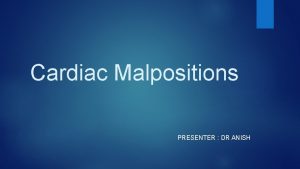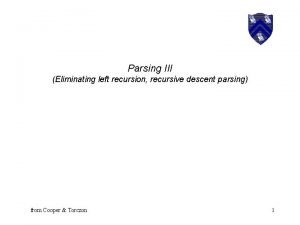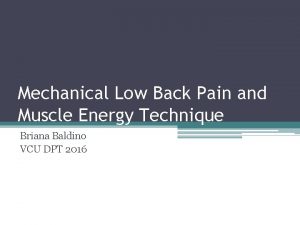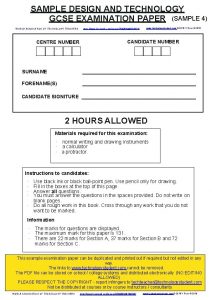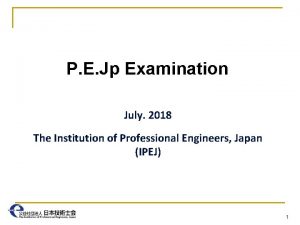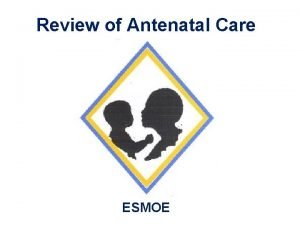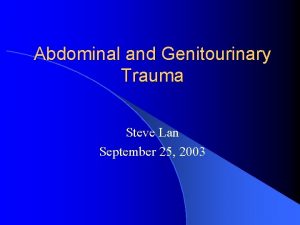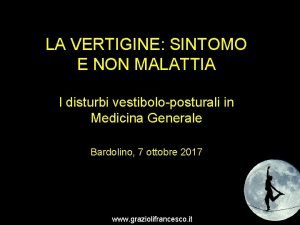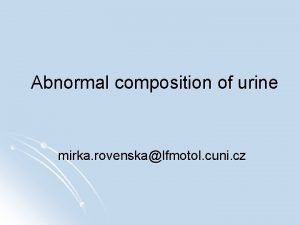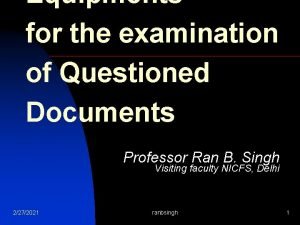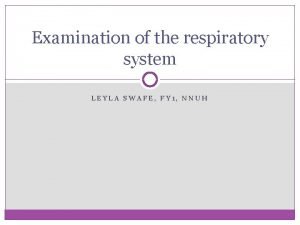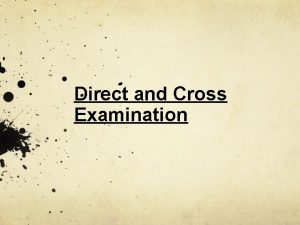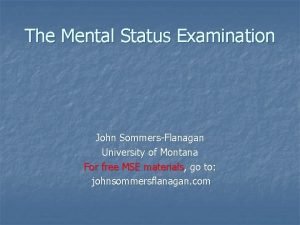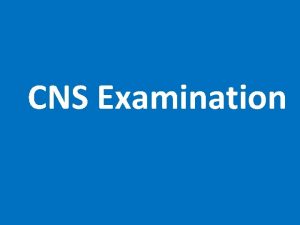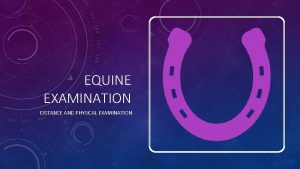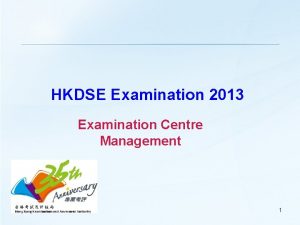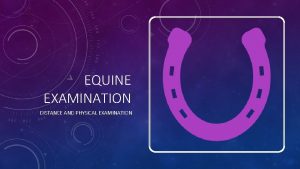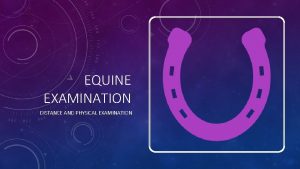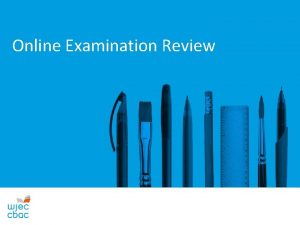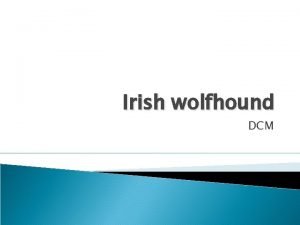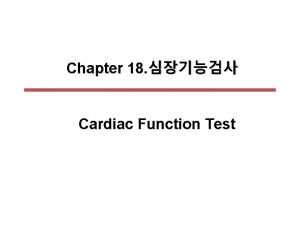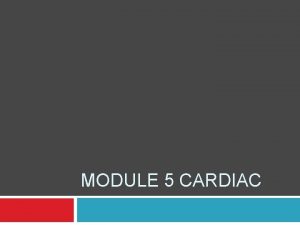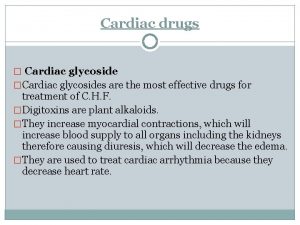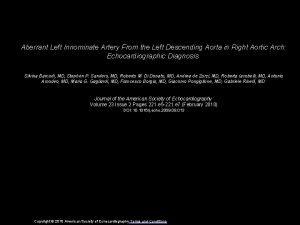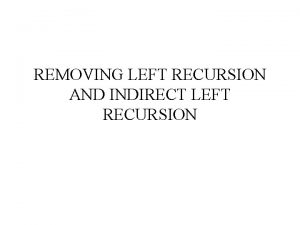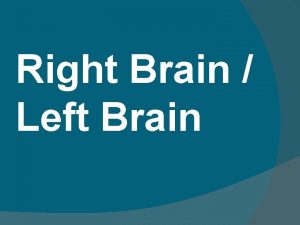Cardiac Examination 1 Cardiac symptoms Symptoms of left



















- Slides: 19

Cardiac Examination 1

Cardiac symptoms Symptoms of left sided heart failure Symptoms of right sided heart failure Symptoms of palpitation Symptoms of cyanosis Symptoms of embolic disease as stroke , hematuria and blindness • Precordial pain • • • 2

A) Symptoms of left sided heart failure In infants • Tachycardia , tachypnea , tender enlarged liver • Irritability, weak crying, sweating • Poor feeding and failure to thrive In children 1 - Manifestation of LCO • • • Renal – oliguria Cerebral – headache , syncope Coronary – angina pectoris Muscle – easy fatigability , claudication Skin--- pale cold skin

2 - Manifestation of pulmonary congestion • Cough , dyspnea, cyanosis and hemoptysis B) Symptoms of right sided heart failure (Manifestation of systemic congestion) • • • Insomnia Congested pulsating neck veins Enlarged tender liver Ascites Edema of lower limbs

Cardiac examination A)Inspection: • 1)Shape of precordium: no precordial bulge • 2)Apex: visible, localized, at normal site • 3)other pulsations B)Palpation: • 1)Apex: , site, size, characters, thrill • 2)Other pulsations: absent a)precordial: pulmonary, parasternal(Lt, Rt) b)extra-precordial: suprasternal, epigastric 3)Thrills: absent 5

C)Percussion: upper border of the liver, right border of the heart, base, apex, lt border D)Auscultation: 1)Heart sound: 1 st, 2 nd heart sounds are audible 2)Additional sounds: 3 rd, 4 th heart sounds, ejection click 3)Murmurs: systolic, diastolic, continous are absent 6

Cardiac examination A)Inspection: 1)Shape of the precordium: looking from the feet the precordial area to detect if there is precordial bulge or not, normally no precordial bulge 2)Apex: lowermost outermost visible pulsation normally: the apex is visible, localized, at normal site according to age shifted laterally(outward): RV enlargement shifted laterally(outward)&downward: LV enlargement absent: in obesity, pericardial or pleural effusion , emphysema, dextrocardia 3)Other pulsations: normally they are absent 7

Pulsation can be classified into: a)precordial: apex, pulmonary, aortic, Lt parasternal , Rt parasternal b)extra-precordial: suprasternal, epigastric B)Palpation: 1)Apex: place the middle of the palm of the right hand in contact with the chest wall at the area of the visible apex then place the tip of the middle finger vertically over this area normal findings: 1)site: 0 -2 yr: in the 4 th Lt intercostal space(ICS) outside midclavicular line(MCL) 2 -7 yr : in 4 th Lt ICS at MCL over 7 yr : in 5 th Lt ICS at MCL 8

2)Size: localized or diffuse(>1 space or >2 cm) 3) Rhythm: regular 4) Character: normally no special character a) slapping(not strong, not sustained): RV apex b) heaving(strong, sustained): LV pressure overload(AS, hypertension) C) hyperdynamic(strong, not sustained): LV volume overload(AR, MR, VSD) 5)Thrill: no palpable thrill 9

• 2)Other pulsations: a) pulmonary area: diastolic shock: it is palpable accentuated 2 nd heart sound in the pulmonary area due to pulmonary hypertension method: the patient sits in bed, leans forwards and holds his breath in expiration while putting the finger tips of the examinar in the pulmonary area b) Aortic area: pulsations in aortic dilatation as in AR or AS c) Left parasternal area: pulsations due to RV dilatation or RV hypertrophy 10

d)Right parasternal area: pulsations due to RA dilatation e)Suprasternal area: pulsations due to AR, hyperkinetic states (fever, anemia, hyperthyrodism) f)Epigastric pulsations: originating from one of three: 1)RV(felt from left side ): due to RV hypertrophy or dilatation 2)Aortic(felt from backwards-forward): due to aortic aneurysm or in thin children 3)Hepatic (felt from right side ) 11

3)Thrills: palpable murmurs, felt as vibrations, presence of thrill means presence of murmur greater than grade 3 C)Percussion: 1) 1 st: determine the upper border of the liver at the Rt MCL 2) For the Rt border of the heart: start at one ICS above the upper border of the liver, percuss from outside inwards toward the heart 3) For the base(upper border): percuss the 2 nd space on either side(rt then lt) 4) For the apex: start percussion at some distance to the left of position of the palpable apex 5) For the left border: percuss from left toward the heart at spaces between apex(5 th space)and base(2 nd space) 12

Normally: 1)upper border of liver is at 5 th space 2)No dullness outside rt sternal border(dullness in RA dilatation) 3)both 2 nd spaces are resonant(dullness in PS, AS 4)No dullness outside palpable apex(dullness in RV or LV enlargement) 13

D)Auscultation: Area of auscultation: 1) Mitral area: the apex 2) Pulmonary area: 2 nd Lt ICS 3) 1 st aortic area: 2 nd Rt ICS 4) 2 nd aortic area: 3 rd. Lt ICS 5)Tricusped area: lower left sternal border 6)Back: interscapular area(for murmurs of CHD e. g: coarctation of aorta 14

Items of auscultation: 1)Heart sounds: 1 st &2 nd heart sounds: normally audible 2) Additional sounds: 3 rd&4 th heart sounds, ejection click , pericardial rub: normally absent 3) Murmurs: systolic, diastolic and continuous: normally absent A)1 st heart sound(S 1): a)Audible: normally b)Inaudible: in obesity, pericardial or pleural effusion , emphysema c)Muffled: in MR(masked by the pansystolic murmur) d)Accentuated: in MS 15

B) 2 nd heart sound(S 2): a) Audible: normally b) Accentuated: in pulmonary hypertension, systemic hypertension 16

2 )Murmurs: a)Timing: systolic, diastolic, continous b)Site of maximum intensity c)Propagation: radiation to other areas e. g: the pansystolic murmur of MR is propagated to the axilla d)Character: soft blowing(MR), harsh(VSD, AS, PS), machinary(PDA) e)Grade: 6 grades for murmurs(thrill is present in the last 3 grades): grade 1: very faint grade 2: faint 17

grade 3: moderately loud grade 4: loud with thrill grade 5: very loudwith thrill grade 6: very loud with thrill 18

Thank you 19
 Heart tube
Heart tube Left left right right go go go
Left left right right go go go Stage right and stage left
Stage right and stage left Recursive descent parser left recursion
Recursive descent parser left recursion Go straight ahead and turn right
Go straight ahead and turn right You put your left foot in
You put your left foot in Muscle energy technique si joint
Muscle energy technique si joint Left left right right go turn around
Left left right right go turn around Do pregnancy cramps feel like period cramps
Do pregnancy cramps feel like period cramps Activity 10-3 examination of u.s. currency answer key
Activity 10-3 examination of u.s. currency answer key Sample design and technology gcse examination paper answers
Sample design and technology gcse examination paper answers P.e.jp
P.e.jp Banc plus checklist
Banc plus checklist Hemoperitoneum symptoms
Hemoperitoneum symptoms Vestiboloplegici
Vestiboloplegici Routine examination of urine
Routine examination of urine Oblique light examination in questioned document
Oblique light examination in questioned document Cricosternal distance
Cricosternal distance Direct examination definition
Direct examination definition Example of mse report
Example of mse report
